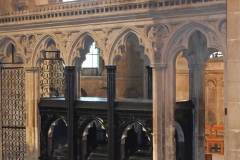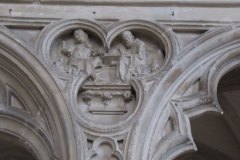Archbishop of Canterbury (1328-1333) – for more see here
Possibly the work of Thomas of Canterbury
The monument of Simon Meopham has more of the appearance of a shrine than a tomb. It is situated across the entrance to Saint Anselm’s Chapel and, with its associated architecture, forms a screen. The tomb chest is made of a black limestone often referred to as Tournai Marble. The stone canopy, with its fine architectural moulding and detailed figurative spandrels, is of Caen Stone. The four supporting marble columns of the canopy conceal elements of the tomb’s pictorial carving suggesting the provision of a canopy may have been an afterthought.
Each of the tomb recesses is vaulted with Caen Stone. Supporting the internal vaults are attached columns in a dark fossiliferous limestone. The columns appear to be carved from the same stone block as their adjacent side panel. Some of the columns are missing or damaged. The stone forming the side panels and columns is a limestone from the Weald Clay Formation. The two wrought-iron gates to either side of the tomb are said to have been made at Mayfield in West Sussex (where Meopham died), the iron presumably having been forged from a local ironstone. If this is the case then it is possible that the limestone panels and the paving that surrounds the tomb is also from this area. In Kent we call such limestones from the Weald Clay Formation, Bethersden Marble. In West Sussex, similar limestone from the same geological formation goes by the name of Laughton Marble, Petworth Marble or Sussex Marble, so this stone may be a Sussex Marble.
Click on the images below to enlarge and read captions
Looking about the tomb at the flooring to north and south it can be seen there is much of this large freshwater snail shell limestone.
On the western side of the step leading into St Anselm’s Chapel can be seen a small block of ‘striped’ limestone. This is usually referred to in the literature as onyx marble, but more recently has been described by Christopher Wilson as calc sinter. It is a precipitate of calcium carbonate forming in layers from flowing lime-rich waters. Wilson has proposed that the stone formed within the Roman aqueduct draining the highland of the Eiffel Region on the Belgium/Germany border. Other sources may be possible.
It is possible that this block came from a column in the infirmary cloister that was dismantled and re-used.
GD


